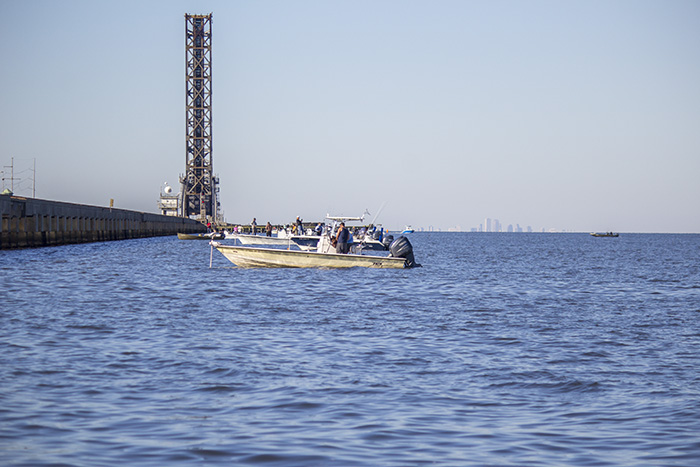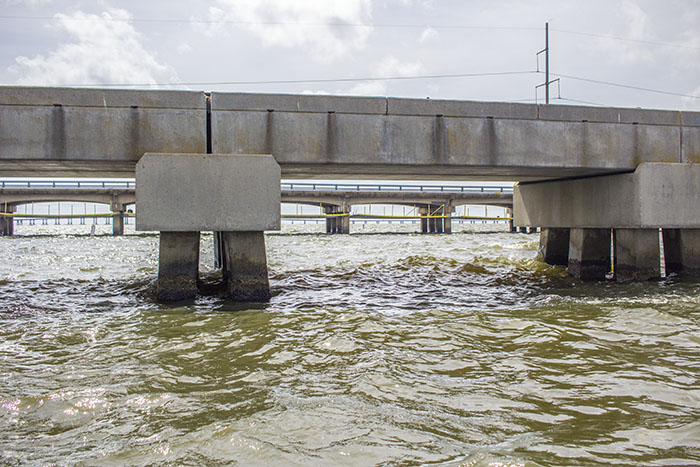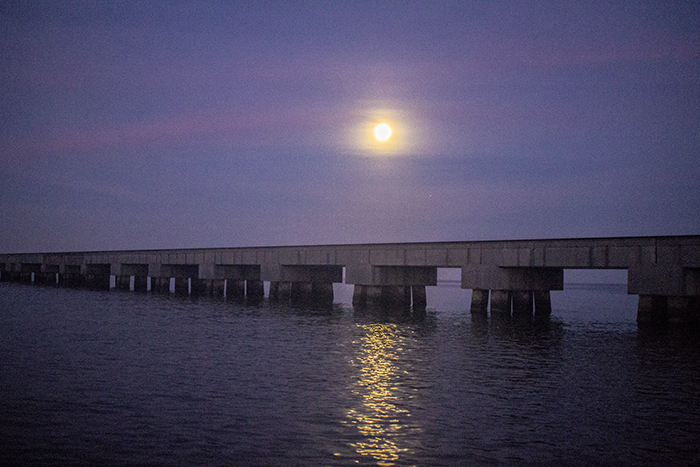My inshore fishing experience is a journey of self-improvement. These fishing trips to Lake Pontchartrain are a part of that journey.
Lake Pontchartrain is a tough place to fish, especially when compared to other parts of Louisiana.
Open water easily stirred by wind and fishing pressure from the Greater New Orleans Area and Northshore are just two reasons I have avoided it like the plague.
Despite living in Slidell, I was always content with making the drive to fishing destinations in St. Bernard and Plaquemines Parishes.
There were more options, the water was protected from wind and I could fish without being pestered by the "Inshore Armada".
At the time, finding limits of fish was hard enough, I didn't want to compete with scores of boats to do it, either.

I always hated dealing with this. Now I am fine with it and don't mind having an audience when I sling trout into the boat.
The Inshore Dojo of Roll Casting and Jigging
I eventually learned the key to successful angling is "fishing smarter" and thus began my journey.
My perspective on fishing is closer to that of Bruce Lee's to martial arts than it is to Andy Griffith's soaking a worm.
My determination can become a borderline obsession on railroad tracks with hundreds of tonnage behind the engine: nothing is going to stop me, not even myself.
Coming out of my comfort zone is a routine I regularly undertake in my journey.
It flies in the face of a lot of fishing wisdom, especially "use what you are confident in."
I will go straight to a shoreline I have never fished and start working it with a lure I have never used.
I have burned a lot of empty shoreline and made many fruitless casts, but when I finally set the hook my fishing skill and confidence is multiplied exponentially.
It's my shortcut to becoming a lethal angler.
So it was a no-brainer that I should learn the skills to succeed in a place like Lake Pontchartrain, specifically her record trout-yielding bridges.
I had to master several skills
It was obvious I had to learn, practice and master a set of skills in order to succeed. That training wouldn't begin on the day I actually wanted to fish, but well before that day.
These skills include:
- roll casting
- pitching
- advanced lure control
- working a foot pedal trolling motor
Technical Casting
I practiced pitching and roll casting with a baitcaster.
I already had these skills, they just weren't so polished. I'd go to the Trestles and Hwy 11 bridges on days it was calm enough to practice working the foot pedal, roll casting and pitching at the bridges.
Often I'd end up smacking the side of the bridge, deforming the jighead and not placing the lure where I wanted it.
What makes it tough: These bridges offer a unique challenge in that one can't cast the same way they do in the marsh.
There is overhead structure keeping one from making "rainbow casts" or any kind of cast that would cause the lure to fly high into the air.
I had to be able to cast in such a manner that the lure would fly low and under the bridge before entering the water.
I talk more about this in my fishing report from 4/11/17.
Trestles Again 4/11/17
I’d pitch or roll cast to the pilings, let the lure drop straight down by letting additional slack out...
...not letting it “swing” towards me on a tight line...
...then reel the slack in, wait for the bow in the line to dip before jigging, letting the Matrix Shad glide to the bottom, reeling in slack and repeating the process.
Jig, jig, glide….jig, jig, glide….jig, jig, glide…
The Foot Pedal
I always hated foot pedal trolling motors.
However, professional anglers with millions in tournament winnings use them. It's a great way to free up my hands and move the boat at the same time. So I found a used one for a great deal and hopped on it.
At first it was awkward.
Sometimes I almost fell over onto my behind, but I stuck with it and it became natural. I wouldn't let myself use my old remote-controlled trolling motor.
Honestly, I don't know how I fished without a foot pedal before.
Coming out of my comfort zone and trying something I hated really paid off for me here.

These bridges have a lot to teach, if you are willing and ready to improve as an angler. Otherwise they will leave you humbled.
Jigging Like a Boss
During the winter I had a lot of success catching hundreds of speckled trout using jigging techniques.
However, the geometry of casting in the marsh and against these bridges are two different things. Successfully casting at the bridges and getting the jighead to the bottom for a good presentation is much more difficult.
This is because the jighead has a far shorter horizontal distance to travel the same vertical distance (water depth).
In the marsh, you can cast waaaay ahead of where the "strike zone" is to get the jighead to the bottom, as much as 30 yards.
On the Trestles, you have about 2-4 yards to do the same thing, sometimes less than that.
So I went from an 1/8 oz jighead in the marsh to a 3/8 or even 1/2 oz jighead on the bridges.
As you can read this fishing report from the Trestles, it more than paid off for me.
Lake P Trestles 4/12/17
I eventually finished out the rest of my tags, 74 of them and finished that week of fishing having tagged 134 trout, had at least 40 come unbuttoned in midair and fall back into the water or, more comically, fly out of the water, across the bow and back in the drink.
Another 40 or so came unbuttoned halfway to the boat. Overall, it was a good run of great weather and awesome fishing. I left them biting and headed back in to get work done.
I would practice casting and jigging so much that I would have dreams of it. I'd fall asleep and see bridge pilings before a soft plastic shot out, landing between them and beginning it's underwater mission through a series of "jig, jig, glide" techniques.
Am I being a little crazy?
Yes.
The Louisiana Fishing Blog has been successful. Like....really successful. I think a lot of that has to do with the reality that I actually fish.
A lot of people in the industry don't fish much, if at all, but are quick to sell you their products and services. I even watched a guy promote a rod he had never caught a fish on.
I just want you to catch more fish and have fun doing it. I could care less for the salesy hyperbole.
In my heart lies a genuine passion for inshore fishing that may seem like fanaticism to the uninitiated.
But anyone who was watched a full moon set over Lake Pontchartrain during the spring trout run knows that it's perfectly okay.

The reality is that fishing is more than "just fishing".
Within the fishing trips that make up my inshore journey are a series of life lessons, universal truths if you will, that lead me to be a better human being.
Whether it's altruism, appreciation of the small things or a big ol' slice of humble pie, fishing gives me the opportunity to learn more about myself.
I learn what I am capable of and where my place in the world is.
I spent five days in the last week fishing the bridges in perfect and crappy conditions. I am a phenomenally better angler than what I was just seven days ago.
The feeling is a good one and my hard work has paid off.
So, I share this experience of "seeking a new level" with you in hopes that it can do the same thing for you that it did for me. If I can successfully do that, then we all win.
Our wetlands win, the trout win, anglers win.
We all win.
